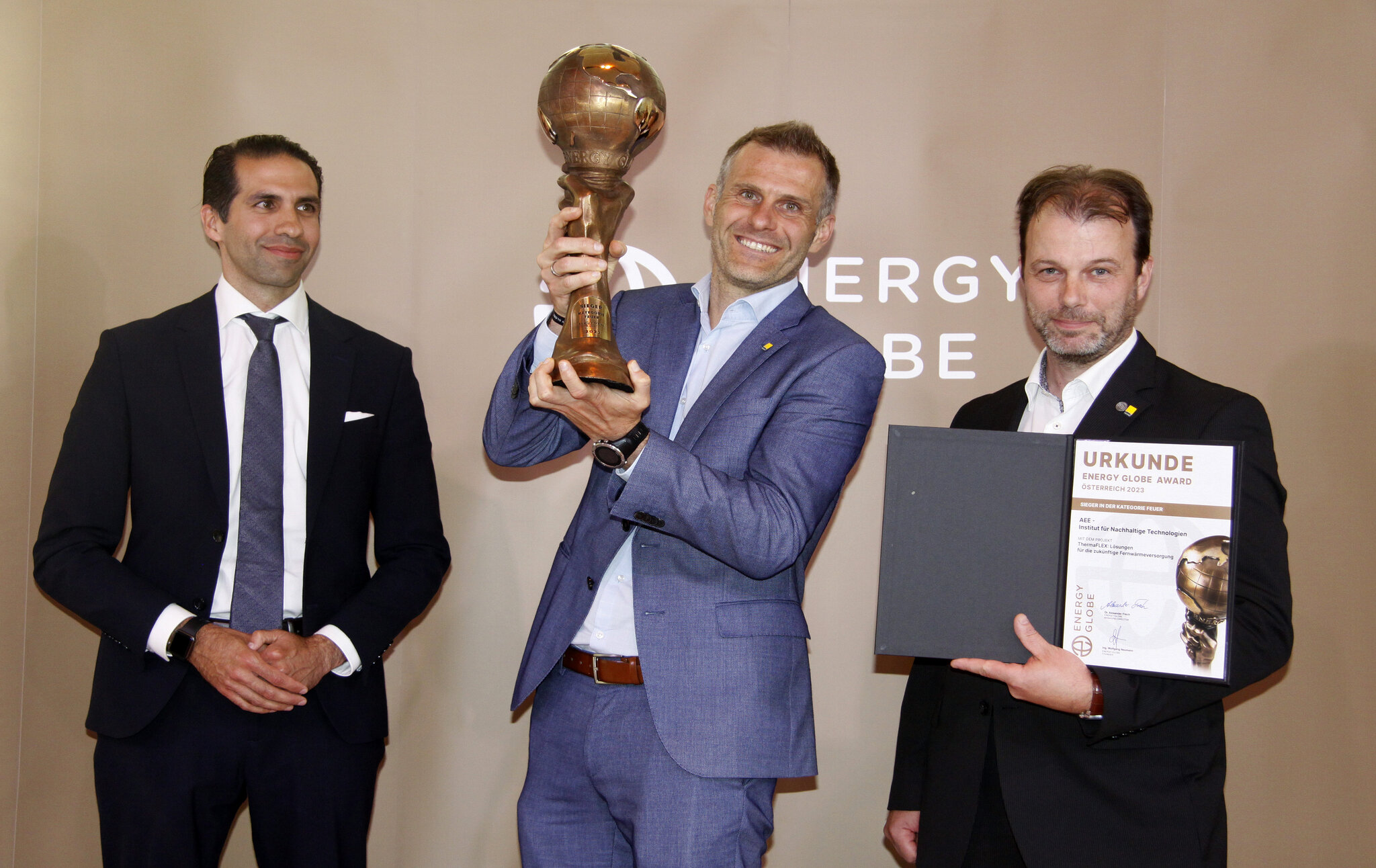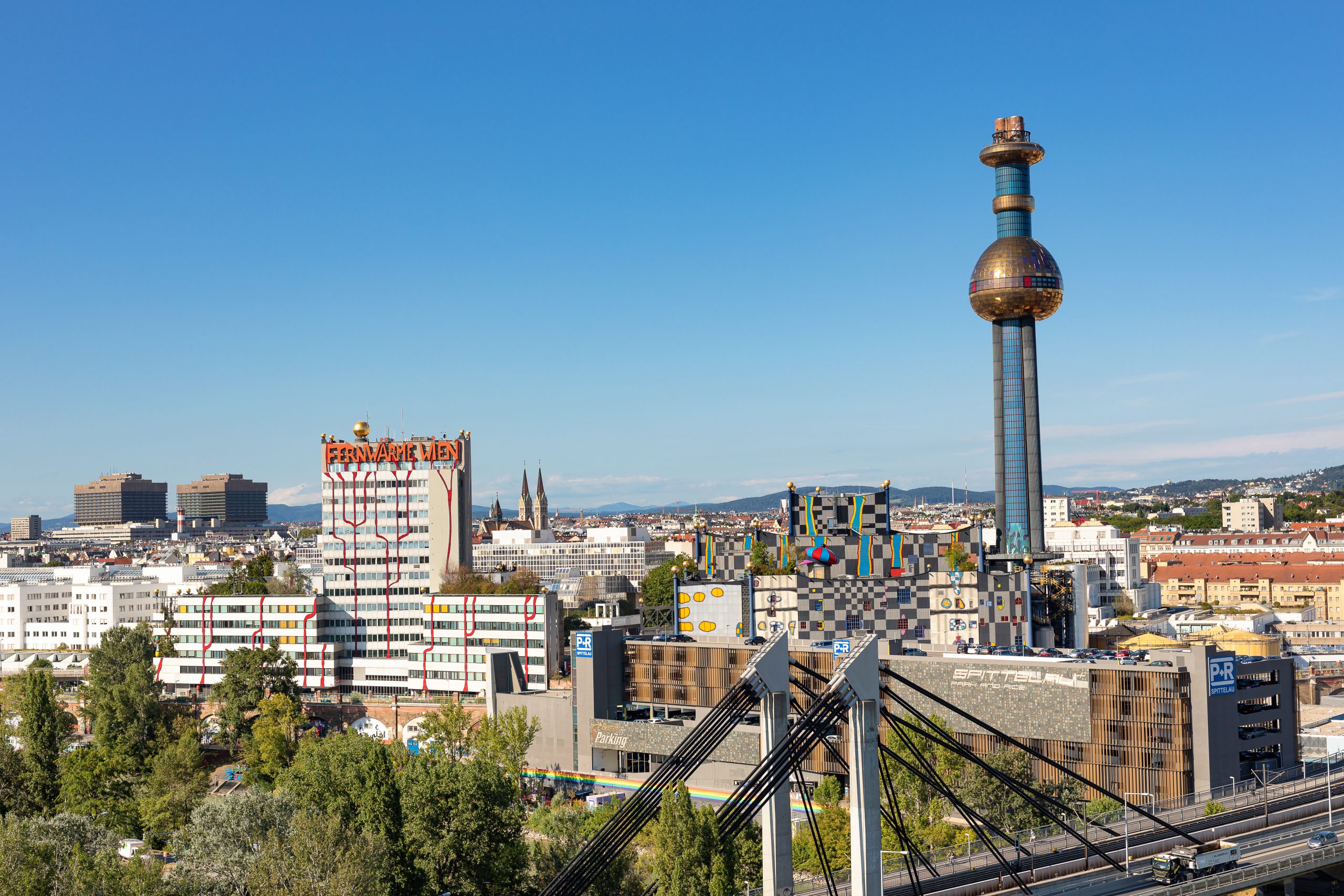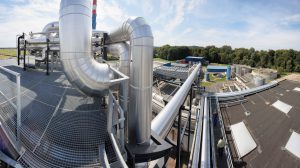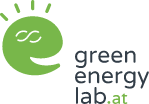Research project ThermaFLEX wins the Energy Globe Austria
The lead project ThermaFLEX of the "Vorzeigeregion Energie - Green Energy Lab" was awarded the sustainability prize Energy Globe Austria in the category "Fire" on June 13.

Joachim Kelz (center) and Ingo Leusbrock (right) from AEE Intec are pleased about the victory of the project “ThermaFLEX” at the Energy Globe Austria in the category “Fire”. The prize was presented by Stephan Sharma (left), Chairman of the Board of Burgenland Energie. © Green Energy Lab
Vienna, 14.06.23 – In the decarbonization of district heating, i.e. an operation independent of coal, oil and natural gas, lies a huge lever for greenhouse gas reduction in the fight against climate change. The large-scale research project ThermaFLEX tests the flexible district heating network of tomorrow by integrating local, sustainable heat sources and was awarded the Energy Globe Austria in the category “Fire” for this project. In the future, around 45,000 tons of CO2 will be directly saved in district heating each year. The research results also serve as a basis for making the entire district heating sector more flexible.
45,000 tons of CO2 saved per year
ThermaFLEX demonstrates with concrete solutions how the existing heat pipe infrastructure can be efficiently used and extended to integrate sustainable, local heat sources into the supply. On the basis of ten large-scale demonstration projects, 28 partners in Styria, Vienna and Salzburg proved that large-scale technical implementations are also possible in a relatively short time. When all demonstrators are realized, this will result in direct annual CO2 savings of around 45,000 tons Furthermore, the solutions developed can be transferred to other heating networks. Thus, the research work performed contributes to the flexibilization of the entire district heating sector – a basic prerequisite for the increased use of sustainable heat sources, the phase-out of fossil fuels and the reduction of the “carbon footprint”.
“To accelerate the energy transition even further, we also need innovative solutions. There is great potential in the heating sector in particular. ThermaFLEX is one of the largest projects of the ‘Vorzeigeregion Energie’ from the Climate and Energy Fund. And it is the largest innovation project in the Austrian district heating sector to date,” explains Climate Protection Minister Leonore Gewessler.
Applied research in the field of renewable energie
The ThermaFLEX project is worth around 4.6 million euros, is funded by the Climate and Energy Fund and is being carried out as part of the “Green Energy Lab” research initiative as part of the Austrian innovation offensive “Vorzeigeregion Energie”. Innovations are being researched in the Green Energy Lab. These are tested in practice and thus rapidly developed to market maturity. Mathias Schaffer, chairman and spokesman of the board of the Green Energy Lab, is correspondingly pleased with the award.: “We as Green Energy Lab are very proud that our flagship project ThermaFLEX has been awarded with the Energy Globe Austria 2023. It is one of the most successful flagship projects in our portfolio. In addition to ThermaFLEX, we currently manage 50 other renewable energy projects with an investment volume of more than 150 million euros.”
Project manager Joachim Kelz from AEE – Institute for Sustainable Technologies (AEE INTEC) is also visibly pleased: “Climate-friendly and sustainable solutions in district heating are the basis for an intelligent heat supply of the future.” ThermaFLEX has provided many important results and insights for this. “In addition to the large-scale implementations that have already taken place in seven Austrian district heating networks, the necessary elements and solutions as well as the knowledge base for a broad roll-out are available far beyond our project. These can now be further developed and applied in numerous national or even international heating networks.” ThermaFLEX is thus making a valuable contribution to the decarbonization of the heating sector, which is responsible for around half of total energy consumption in the EU.

At the Vienna-Spittelau waste incineration plant, the waste heat generated from the incinerator’s
flue gas condensation will in future be used as an energy source for a high-temperature heat pump.
The thermal output of the heat pump concept will be around 16 MW (megawatts). © Wien Energie / Schedl
District heating as a key factor in the fight against climate change
Every fourth household in Austria is connected to a district heating network. Today, however, renewable energy sources contribute only just under half of the total district heating demand. For this to change, many small, local heat sources will also have to be integrated into the grid in the future. To this end, 5,600 kilometers of heating pipeline infrastructure in Austria must be increasingly fed by renewable heat. Currently, district heating is mainly generated centrally and in a small number of plants. Most of the energy for this comes from fossil fuels such as oil, gas or coal. Among renewable forms of energy, the generation of heat from biomass plays the most important role, but its availability is limited. Thus, in order to rapidly increase the overall share of renewable energy, other energy carriers and heat sources must also be integrated into the district heating system. This conversion requires increased decentralization of the entire district heating sector. With the increasing number of power generation plants and their fluctuating availability, the complexity of the heating networks also increases. Flexibilization is therefore in demand – and it was precisely this aspect that was the focus of the ThermaFLEX research project.
Already successfully implemented in seven heating networks
The interaction of different components in real heating networks of different sizes was researched and tested. To this end, various measures have been combined and implemented on a large scale in seven Austrian heating networks to date. A wide variety of heat sources and flexibility elements were used. A central role was played by heat storage systems, the coupling of energy sectors and infrastructures, new intelligent control concepts, large-scale heat pump applications, solar thermal energy, and the integration of a wide variety of locally available waste heat sources – from heat recovery from rendering to the use of residual heat and cooling from wastewater.
More information on the individual demonstration projects and ThermaFLEX can be found here: www.greenenergylab.at/projects/thermaflex/?lang=en

Waste heat utilization from a rendering plant in Gabersdorf (Styria) for district heating.
© Klimafonds / Krobath
About Green Energy Lab
Green Energy Lab is the largest innovation laboratory for sustainable energy solutions in Austria and part of the “Vorzeigeregion Energie” of the Climate and Energy Fund. More than 300 participating partners from research, business and the public sector join Wien Energie, EVN, Energie Burgenland and Energie Steiermark in bringing new ideas for the energy future to life.
Further Information: www.greenenergylab.at
About AEE INTEC
AEE – Institute for Sustainable Technologies (AEE INTEC) was founded in 1988 and is today one of the leading European institutes of applied research in the field of renewable energy and resource efficiency. The range of R&D projects carried out extends from basic research projects to the implementation of demonstration plants.
Further Information: www.aee-intec.at
Queries & Contact
Green Energy Lab
Eng. Mag. Ludwig Fliesser
Communications Manager
SPACES Icon | Gertrude-Fröhlich-Sandner Straße 2
1100 Wien
T: +43 676 471 934 7
E: ludwig.fliesser@greenenergylab.at
W: www.greenenergylab.at
AEE – Institut für Nachhaltige Technologien
DI (FH) Joachim Kelz
Feldgasse 19
8200 Gleisdorf
T: +43 3112 5886-236
E: j.kelz@aee.at
W: https://www.aee-intec.at/
Contact
Ludwig Fliesser
Communications Manager
T: +43 676 471 93 47
E: ludwig.fliesser@greenenergylab.at
